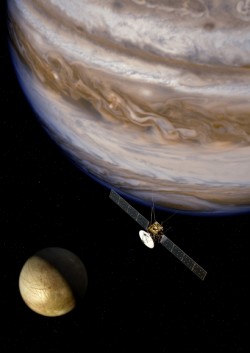Jackson School Scientists Part of Science Team for Space Probe to Jupiter’s Icy Moons
May 11, 2012

The European Space Agency recently announced that it will send a space probe to Jupiter and its large icy moons Callisto, Ganymede and Europa. Scientists at the University of Texas at Austin’s Institute for Geophysics, including Don Blankenship, senior research scientist, are part of the science team designing and operating a radar instrument for the JUICE (Jupiter Icy moons Explorer) spacecraft. The anticipated launch date is June 2022.
Jonathan Amos, reporting for BBC News, noted the primary motivation for the mission:
“Emphasis would be put on ‘habitability’ – in trying to understand whether there is any possibility that these moons could host microbial life. Callisto, Europa and Ganymede are all suspected to have oceans of water below their icy surfaces. As such, they may have environments conducive to simple biology.”
Last year, Britney Schmidt, postdoctoral fellow in the Jackson School (also working on the radar science team for JUICE), announced the discovery of a large liquid water lake within the icy shell of Europa and signs that many more of these lakes might exist across the enigmatic moon of Jupiter. These lakes are distinct from an even larger liquid ocean long hypothesized to exist below Europa’s ice shell. The finding opens up more potential target sites to search for life and a mechanism to deliver nutrients from the surface to the deeper ocean, possibly raising the odds that life could take hold there.
“We know that ice is a really good place [for life] to do business on Earth,” Schmidt told the BBC. “There’s plenty of microbial and even some macroscopic organisms that use ice to make a living. It’s not so hard to imagine that life like that which lives in Antarctica and in the Arctic might be very possible on Europa.”
The radar data collected by JUICE will provide scientists with the first measurements of the thickness of Europa’s icy crust and help identify candidate sites for a future mission that would actually land on the surface for closer exploration.
